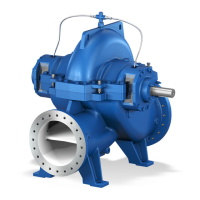RDLO
Page 12 of 24
7.2 Servicing / Inspection
7.2.1 Supervision of Operation
The pump should run quietly and
free from vibrations at all times.
The pump must never be allowed to run dry.
Prolonged operation against a closed shut-off
element is not permitted in order to prevent the
medium handled from heating up.
At room temperatures of up to 30 °C (86 °F) the
bearing temperature should not exceed 90 °C (194
°F). At higher room temperatures, the bearing
temperature should be below 100 °C (212 °F).
With oil-lubricated bearings, the correct oil level
must be checked at regular intervals.
During pump operation the shut-off element
in the inlet line must not be closed.
Any stand-by pumps installed should be switched
on and then immediately off again once a week to
keep them operational.
Attention should be paid to the correct functioning of
the auxiliary connections.
If the flexible coupling elements
begin to show signs of wear, they
should be replaced in due time. See operating
instructions of the drive coupling in section 9.3.
If the liquid for sealing, cooling and lubricating is
taken from an external source, the pressure must
be 1.0 to 2.0 bar higher than at the suction nozzle.
7.2.2 Servicing of the Shaft Seal
Service the mechanical seal as outlined in section
9.5 of the manual.
Gland packings have to be packed with fresh
packing material as described in section 7.4 of this
manual after each extended period of standstill,
after each repair and as a remedy against an
excessive leakage rate. It is, therefore,
recommended to observe the leakage rate whilst
the pump is in operation, also to stop the gland
becoming hot.
7.2.3 Servicing of the Bearings
7.2.3.1 Grease-lubricated Bearings
The rolling element bearings have been packed
with grease at the factory. Bearings and grease fill
have to be checked prior to commissioning/start-up.
If there is reason to suspect that shipment and/or
storage may have resulted in dirt or condensed
water collecting in the bearing, or that the grease
has become resinous or that it has run out, the
bearing has to be filled with a new supply of grease
before commissioning/start-up of the pump. In
addition, the grease has to be changed each time
the bearing is dismantled/re-assembled, at the
latest after two years.
Before packing the bearing with fresh grease, clean
the bearing itself, the bearing housing and bearing
cover with benzine, benzene or similar, and remove
all of the washing agent when finished. Fill the
hollow spaces between the rolling elements of the
bearings to capacity and the bearing covers
approximately half-way with grease, taking care to
observe the greatest possible cleanliness.
The bearing is re-lubricated with a grease gun by
means of the lubricating nipples at the bearing
covers. Use a high-quality, lithium soap-based
bearing grease that is free from resin or acid, is not
liable to crumble, and has good rust-preventive
characteristics. The grease should have a
penetration number between 2 and 3, which
corresponds to a worked penetration between 220
and 295 mm/10. The drop point should not be
below 175 °C.
Lubricating intervals, lubricant quantities as well as
the recommended type of grease are indicated in
the technical data of the pump in section 9.2.
Re-lubrication is only allowed with the pump in
operation.
7.2.3.2 Oil-lubricated Bearings
A constant-level oiler is provided on each bearing
housing of the pump.
Function of Constant-level Oiler
When the oil level in the bearing falls, the oil level in
the connection elbow supplying oil to the bearing
falls as well. This decrease in the oil level uncovers
the opening of the angular-cut pipe, and air enters
the oil reservoir. Consequently, a corresponding
quantity of oil can flow from the oil reservoir through
the pipe to the bearing housing, re-establishes the
predetermined oil level and covers the opening of
the angular-cut pipe again.
This process is repeated as often as the oil level in
the bearing housing drops - until the oil reservoir is
empty. The oil level can be easily checked through
the transparent oil reservoir.
The constant-level oilers must be fitted and filled
with oil prior to commissioning/start-up.
Caution
Caution

